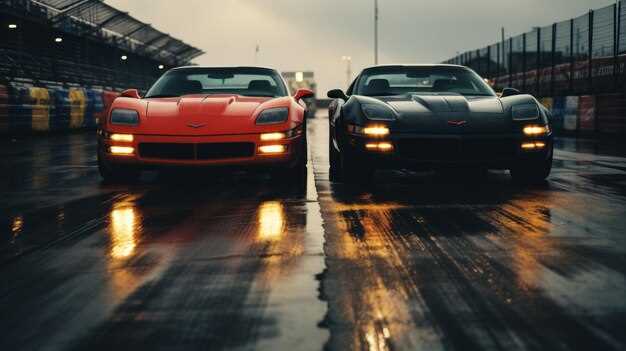
The rivalry between Chevrolet and Dodge has been a cornerstone of American automotive culture, particularly within the realm of racing. Over the decades, these two giants have engaged in a fierce competition that has captivated enthusiasts and casual fans alike. From the muscle car era of the 1960s to the modern day, both brands have continuously pushed the envelope in terms of performance, innovation, and style.
During the early years, Chevrolet emerged as a dominant force with its iconic models like the Camaro and Corvette, attracting a loyal following among racing aficionados. Meanwhile, Dodge countered with its powerful Challenger and Charger, appealing to those who craved raw power and aggressive design. This intense rivalry not only fueled advancements in automotive engineering but also inspired a generation of racers and fans to embrace the thrill of competition.
As we delve into the history of Chevrolet and Dodge’s racing rivalry, we will explore key moments, notable vehicles, and the influence of this enduring competition on motorsports. The story is one of passion, innovation, and the relentless pursuit of speed that has defined the legacy of both brands. Join us as we take a closer look at how this rivalry has evolved and impacted the world of racing over the decades.
Performance Innovations: Key Racing Technologies of Chevrolet and Dodge

Chevrolet and Dodge have been at the forefront of racing technology, each contributing innovations that have shaped the motorsports landscape. The rivalry between these two automotive giants has sparked groundbreaking advancements aimed at enhancing performance, speed, and overall racing capabilities.
Chevrolet’s engineering prowess is evident in its development of advanced engine technologies. The introduction of the small-block V8 engine revolutionized performance in the 1950s, providing a compact yet powerful powertrain. This innovation paved the way for legendary models like the Chevrolet Camaro and Corvette, which dominated both street and track. Additionally, Chevrolet has consistently pushed the envelope with innovations such as fuel injection systems and advanced aerodynamics, which have significantly improved acceleration and handling.
Dodge, on the other hand, has made remarkable strides with its HEMI engine technology, known for its hemispherical combustion chambers that optimize airflow and combustion efficiency. This design has provided Dodge vehicles with exceptional power outputs, particularly in their racing-focused models like the Dodge Charger and Challenger. Furthermore, Dodge has embraced modern advancements such as lightweight chassis materials and high-performance tire designs, resulting in improved traction and stability during high-speed racing.
The competition between Chevrolet and Dodge extends beyond engine performance to include suspension technology. Chevrolet has introduced systems like the Magnetic Ride Control, which adjusts damping in real time to enhance comfort and handling precision. In contrast, Dodge has focused on developing robust, adjustable suspension setups, allowing drivers to fine-tune their vehicles for specific racing conditions. These innovations are pivotal, giving both brands a competitive edge on the racetrack.
As racing continues to evolve, both Chevrolet and Dodge remain committed to pushing the boundaries of performance through research and development. Their ongoing rivalry not only fuels technological advancements but also excites fans and enthusiasts around the world, each eagerly anticipating the next leap in racing innovation from these iconic brands.
Iconic Racing Models: A Comparison of Chevrolet and Dodge’s Legendary Cars

The racing rivalry between Chevrolet and Dodge has produced numerous iconic models that have left an indelible mark on motorsports. Both manufacturers have developed powerful, innovative cars throughout the decades, each with distinct characteristics and strengths.
Here, we explore some of the most legendary racing models from each brand, highlighting their contributions to automotive performance and racing history.
Chevrolet’s Iconic Racing Models
- Chevrolet Corvette: Introduced in 1953, the Corvette quickly became a symbol of American performance. The Corvette Racing team has achieved significant success in endurance racing, showcasing the model’s capabilities on tracks like Le Mans and Daytona.
- Chevrolet Camaro: Launched in 1967, the Camaro has been a fierce competitor in various racing events, including the Trans-Am series. Its combination of speed and agility has made it a favorite among racers and enthusiasts alike.
- Chevrolet Impala: The Impala has a rich NASCAR heritage, dominating the circuits in the 2000s. With impressive power and aerodynamics, it solidified Chevrolet’s reputation in stock car racing.
Dodge’s Iconic Racing Models
- Dodge Charger: Since its debut in 1966, the Charger has been a consistent presence in both drag racing and NASCAR. Its muscle car lineage and powerful performance have made it an enduring symbol of speed.
- Dodge Challenger: Revived in 2008, the Challenger embraces its classic muscle car roots while providing modern performance. Frequently featured in drag races and muscle car competitions, it reflects Dodge’s commitment to performance.
- Dodge Dart: Although primarily known as a compact car, the Dart made its mark in the racing scene during the 1960s. The Dodge Dart Swinger was particularly successful in NHRA drag racing, proving that speed comes in various forms.
Head-to-Head Comparisons
- Performance: Chevrolet models like the Corvette often emphasize precision handling and lightweight construction, while Dodge emphasizes raw power and aggressive styling with models such as the Charger and Challenger.
- Innovation: Chevrolet has pioneered various technologies, including fuel injection and advanced aerodynamics, while Dodge has focused on supercharging and high-displacement engines to boost performance.
- Heritage: Both brands have rich racing histories, but Chevrolet’s success in endurance racing and NASCAR contrasts with Dodge’s dominance in drag racing and muscle car events.
In conclusion, both Chevrolet and Dodge have created legendary racing models that continue to inspire and captivate car enthusiasts around the world. Their rivalry has driven innovation and performance, ensuring that their cars remain at the forefront of motorsport history.
Cultural Impact: How Chevrolet and Dodge Shaped American Motorsports
The rivalry between Chevrolet and Dodge has profoundly influenced American motorsports, carving a distinct identity for each brand within the racing community. Chevrolet, with its storied legacy in stock car racing, particularly through the NASCAR series, has developed a strong following among fans who appreciate its innovative engineering and competitive spirit. Iconic models such as the Chevrolet Camaro and Chevy Impala have become symbols of performance, contributing to the brand’s reputation for speed and reliability on the racetrack.
Dodge, on the other hand, has made its mark by leveraging its rich heritage in motorsports, especially through its muscle car lineage. The Dodge Charger and Challenger have not only been staples in various racing circuits but have also captured the hearts of enthusiasts. By investing in high-performance technology and showcasing drivers who push the limits, Dodge has solidified its place as a formidable contender in the racing arena.
The cultural impact of both brands extends beyond the mechanics of racing; they embody the American spirit of competition and innovation. Events such as the Indianapolis 500 and Daytona 500 have seen countless battles between Chevrolet and Dodge, fueling fan loyalty and inspiring a generation of racers. This rivalry has given rise to subcultures surrounding vehicle modifications, grassroots racing, and community engagement, as fans rally around their favorite brands.
Moreover, the fierce competition has driven advancements in automotive technology, safety features, and performance enhancements that benefit consumers beyond the racetrack. By continually pushing each other to innovate, Chevrolet and Dodge have not only shaped the landscapes of motorsports but have also influenced the broader automotive industry.
In summary, the cultural significance of Chevrolet and Dodge in American motorsports reflects a deep-seated passion for racing that resonates with fans and drivers alike. Their ongoing rivalry has fostered a vibrant community and propelled advancements in automotive technology, ensuring that both brands remain iconic in the annals of motorsport history.




